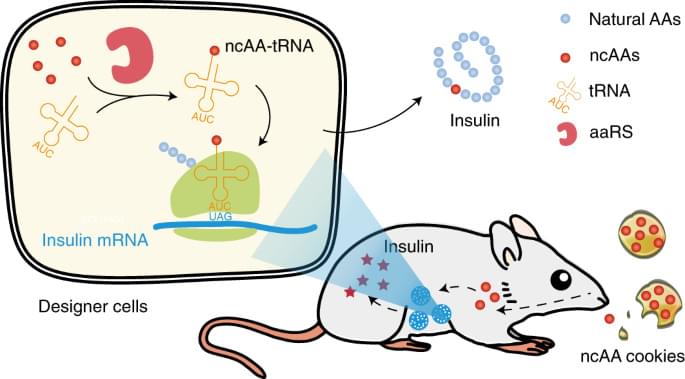The development of a genetic code expansion-based system enables fast protein expression in response to a noncanonical amino acid. The system was implanted into diabetic mice to rescue hyperglycemia with oral delivery of the amino acid.



IBM has created a quantum processor able to process information so complex the work can’t be done or simulated on a traditional computer, CEO Arvind Krishna told “Axios on HBO” ahead of a planned announcement.
Why it matters: Quantum computing could help address problems that are too challenging for even today’s most powerful supercomputers, such as figuring out how to make better batteries or sequester carbon emissions.
Driving the news: IBM says its new Eagle processor can handle 127 qubits, a measure of quantum computing power. In topping 100 qubits, IBM says it has reached a milestone that allows quantum to surpass the power of a traditional computer.


From super-strength concrete to fortified infrastructure, this is what the ‘wonder material for the 21st century’ is now bringing to construction. For more by Tomorrow’s Build subscribe now — https://bit.ly/3vOOJ98
Executive Producer and Narrator — Fred Mills.
Producer — Adam Savage.
Video Editing and Graphics — Thomas Canton.
Special thanks to Dr Lisa Scullion and University of Manchester. Additional footage and images courtesy of University of Manchester, Absolute Photography, Gerdau Graphene, Graphene Flagship, HS2 Ltd, ICON Technology, Kansas State University, NASA/Pat Rawlings, Nanotech Energy and Skanska.
Follow us on Twitter — https://twitter.com/TomorrowsBuild/
Like us on Facebook — https://www.facebook.com/TomorrowsBuild/
Follow us on LinkedIn — https://www.linkedin.com/company/TomorrowsBuild/
Follow us on Instagram — https://www.instagram.com/TomorrowsBuild/
#construction #architecture #science.
Tomorrow’s Build is owned and operated by The B1M Limited. We welcome you sharing our content to inspire others, but please be nice and play by our rules: http://www.theb1m.com/guidelines-for-sharing.

Nova Scotia sanctuary for captive whales to open 2023.
The Whale Sanctuary Project says it is not possible to release whales straight from captivity into the ocean, because they have never experienced life in the ocean.
The organisation says the sanctuary would give them “lifetime care” in a “natural setting that’s as close as possible to what they would experience in the wild”.

The lack of access to safely managed drinking water now affects some 2.2 billion people worldwide. Addressing this serious problem using existing technologies is a key part of the United Nation’s sustainable development goals – with the organization declaring that everyone should have access to five litres of safe drinking water every day.
This could be achieved in some regions using atmospheric water harvesters (AWHs), which draw clean liquid water out of humid air. There are several different types of AWH, and Lord and colleagues focussed on the solar-driven, continuous-mode AWH (SC-AWH). In such a device, heat from sunlight drives warm, humid air through a heat exchanger where it cools and releases water via condensation. Because a SC-AWH operates during the day when relative humidity tends to be low, it has a low efficiency and it had not been clear which locations worldwide are suited for its use.

What’s New: Today, Intel celebrates the 50th anniversary of the Intel® 4,004, the world’s first commercially available microprocessor. With its launch in November 1971, the 4,004 paved the path for modern microprocessor computing – the “brains” that make possible nearly every modern technology, from the cloud to the edge. Microprocessors enable the convergence of the technology superpowers – ubiquitous computing, pervasive connectivity, cloud-to-edge infrastructure and artificial intelligence – and create a pace of innovation that is moving faster today than ever.
“This year marks the 50th anniversary of the 4,004 chip. Think of how much we’ve accomplished in the past half-century. This is a sacred moment for technology. This is what made computing really take off!” –Pat Gelsinger, Intel CEO
Why It’s Important: The 4,004 is the pioneer microprocessor, and its success proved that it was possible to build complex integrated circuits and fit them on a chip the size of a fingernail. Its invention also established a new random logic design methodology, one that subsequent generations of microprocessors would be built upon, before evolving to create the chips found in today’s modern devices.


Alongside advances in space exploration, we’ve recently seen much time and money invested into technologies that could allow effective space resource utilization. And at the forefront of these efforts has been a laser-sharp focus on finding the best way to produce oxygen on the Moon.
In october, the australian space agency and NASA
Established in 1958, the National Aeronautics and Space Administration (NASA) is an independent agency of the United States Federal Government that succeeded the National Advisory Committee for Aeronautics (NACA). It is responsible for the civilian space program, as well as aeronautics and aerospace research. It’s vision is “To discover and expand knowledge for the benefit of humanity.”